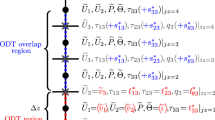Abstract
One-dimensional turbulence (ODT) is a single-column simulation in which vertical motions are represented by an unsteady advective process, rather than their customary representation by a diffusive process. No space or time averaging of mesh-resolved motions is invoked. Molecular-transport scales can be resolved in ODT simulations of laboratory-scale flows, but this resolution of these scales is prohibitively expensive in ODT simulations of the atmospheric boundary layer (ABL), except possibly in small subregions of a non-uniform mesh.
Here, two methods for ODT simulation of the ABL on uniform meshes are described and applied to the GABLS (GEWEX Atmospheric Boundary Layer Study; GEWEX is the Global Energy and Water Cycle Experiment) stable boundary-layer intercomparison case. One method involves resolution of the roughness scale using a fixed eddy viscosity to represent subgrid motions. The other method, which is implemented at lower spatial resolution, involves a variable eddy viscosity determined by the local mesh-resolved flow, as in multi-dimensional large-eddy simulation (LES). When run at typical LES resolution, it reproduces some of the key high-resolution results, but its fidelity is lower in some important respects. It is concluded that a more elaborate empirically based representation of the subgrid physics, closely analogous to closures currently employed in LES of the ABL, might improve its performance substantially, yielding a cost-effective ABL simulation tool. Prospects for further application of ODT to the ABL, including possible use of ODT as a near-surface subgrid closure framework for general circulation modeling, are assessed.
Similar content being viewed by others
References
Cheinet S. (2003), ‘A Multiple Mass-Flux Parameterization for the Surface-Generated Convection. Part I: Dry Plumes’. J. Atmos. Sci. 60, 2313–2327
Cuxart J., et al. (2006), ‘Single-Column Model Intercomparison for a Stably Stratified Atmospheric Boundary Layer’. Boundary-Layer Meteorol. 118, xx–xx
Dreeben T.D., Kerstein A.R. (2000), ‘Simulation of Vertical Slot Convection using One-Dimensional Turbulence’. Int. J. Heat Mass Transf. 43, 3823–3834
Kerstein A.R. (1991), ‘Linear-Eddy Modeling of Turbulent Transport. Part 6. Microstructure of Diffusive Scalar Mixing Fields’. J. Fluid Mech. 231, 361–394
Kerstein A.R. (1999), ‘One-Dimensional Turbulence: Formulation and Application to Homogeneous Turbulence, Shear Flows, and Buoyant Stratified flows’. J. Fluid Mech. 392, 277–334
Kerstein A.R. (2002), ‘One-Dimensional Turbulence: A New Approach to High-Fidelity Subgrid Closure of Turbulent Flow Simulations’. Comp. Phys. Commun. 148, 1–16
Kerstein A.R., Ashurst W.T., Wunsch S., Nilsen V. (2001), ‘One-Dimensional Turbulence: Vector Formulation and Application to Free Shear Flows’. J. Fluid Mech. 447, 85–109
Kosovic B., Curry J. (2000), ‘A Large Eddy Simulation Study of a Quasy-Steady, Stably Stratified Atmospheric Boundary Layer’. J. Atmos. Sci. 57, 1052–1068
L’Ecuyer P. (2004). ‘Random Number Generation’, Chap. 2. In: Gentle J.E., Haerdle W., Mori Y. (eds). Handbook of Computational Statistics. Springer-Verlag, Berlin
Moeng C.-H. (1984), ‘A Large-Eddy-Simulation Model for the Study of Planetary Boundary Layer Turbulence’. J. Atmos. Sci. 41, 2052–2062
Pope S.B. (2000), Turbulent Flows. Cambridge University Press, Cambridge, 771 pp
Schmidt R.C., Kerstein A.R., Wunsch S., Nilsen V. (2003), ‘Near-Wall LES Closure Based on One-Dimensional Turbulence Modeling’. J. Comp. Phys. 186, 317–355
Stevens, B. 2003, ‘DYCOMS-II (RF01)’, http://www.atmos.ucla.edu/~bstevens/dycoms/dycoms.html.
Stull R.B. (1988), An Introduction to Boundary Layer Meteorology. Kluwer Academic Publishers, Dordrecht, 666 pp
Su C.-W., Krueger S.K., McMurtry P.A., Austin P.H. (1998), ‘Linear Eddy Modeling of Droplet Spectral Evolution during Entrainment and Mixing in Cumulus Clouds’. Atmos. Res. 47–48, 41–58.
Wunsch S. (2003), ‘Stochastic Simulations of Buoyancy-Reversal Experiments’. Phys. Fluids 15, 1442–1456
Wunsch S., Kerstein A.R. (2001), ‘A Model for Layer Formation in Stably-stratified Turbulence’. Phys. Fluids 13, 702–712
Wunsch S., Kerstein A.R. (2005), ‘A Stochastic Model for High-Rayleigh-Number Convection’. J. Fluid Mech. 528, 173–205
Author information
Authors and Affiliations
Corresponding author
Additional information
An erratum to this article can be found at http://dx.doi.org/10.1007/s10546-008-9282-1
Rights and permissions
About this article
Cite this article
Kerstein, A.R., Wunsch, S. Simulation of a Stably Stratified Atmospheric Boundary Layer Using One-Dimensional Turbulence. Boundary-Layer Meteorol 118, 325–356 (2006). https://doi.org/10.1007/s10546-005-9004-x
Received:
Published:
Issue Date:
DOI: https://doi.org/10.1007/s10546-005-9004-x




